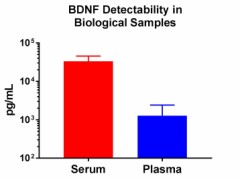- Regulatory Status
- RUO
- Other Names
- Brain-derived neurotrophic factor, ANON2, BLUN2, BDNF, bdnf, BDNF, human bdnf, non-human species bdnf
- Ave. Rating
- Submit a Review
- Product Citations
- publications

-

BDNF levels in serum (n = 20, diluted 1:10) and plasma (n = 18) samples from healthy donors were quantified using the LEGEND MAX™ Human BDNF ELISA Kit. Data are represented as the mean + SD. -

Representative LEGEND MAX™ Human BDNF standard curve.
| Cat # | Size | Price | Quantity Check Availability | Save | ||
|---|---|---|---|---|---|---|
| 446607 | 1 Pre-coated Plate | 525 CHF | ||||
Brain-derived neurotrophic factor (BDNF) is the second member of NGF family of neurotrophic factors (neurotrophins), which includes nerve growth factor (NGF), neurotrophin-3 (NT-3), and neurotrophin-4/5 (NT-4/5). BDNF shares approximately 55% amino acid identity with other family members. The amino acid sequence of mature BDNF is identical in all mammalian species examined to date. Mature BDNF promotes the survival and differentiation of selected neuronal populations of the peripheral and central nervous systems during development. BDNF participates in axonal growth, pathfinding, and in the modulation of dendritic growth and morphology. BDNF is also a major regulator of synaptic transmission and plasticity at adult synapses in many regions of the central nervous system (CNS). High levels of expression of BDNF have been detected in the hippocampus, cerebellum, fetal eye, and placenta. BDNF binds with high affinity and specifically activates the TrkB tyrosine kinase receptor. BDNF is also associated with multiple diseases such as Schizophrenia, Rett syndrome, obsessive compulsive disorder, Huntington’s disease, eating disorders, depression, dementia and Alzheimer’s disease. For example, BDNF level is decreased in Alzheimer’s disease patients’ serum samples.
The BioLegend LEGEND MAX™ Human BDNF Sandwich Enzyme-Linked Immunosorbent Assay (ELISA) kit includes a 96-well strip plate that is pre-coated with a mouse monoclonal anti-human BDNF capture antibody. The detection antibody is a biotinylated mouse monoclonal anti-human BDNF antibody. This kit is specifically designed for the accurate quantitation of the free-form human BDNF from cell culture supernatant, serum, plasma, and other biological fluids. It has been analytically validated with ready-to-use reagents.
Kit Contents
- Kit Contents
-
- Anti-Human BDNF Pre-coated 96-well Strip Microplate
- Human BDNF Dectection Antibody
- Human BDNF Standard
- Avidin-HRP
- Assay Buffer A
- Assay Diluent C
- Wash Buffer (20X)
- Substrate Solution F
- Stop Solution
- Plate Sealers
Product Details
- Verified Reactivity
- Human
- Sensitivity
- 27.5 pg/mL
- Standard Range
- 156.3-1,000 pg/mL
- Materials Not Included
-
- Microplate reader able to measure absorbance at 450 nm
- Adjustable pipettes to measure volumes ranging from 1 µL to 1,000 µL
- Deionized water
- Wash bottle or automated microplate washer
- Log-Log graph paper or software for data analysis
- Tubes to prepare standard dilutions
- Timer
- Plate Shaker
- Polypropylene vials
Antigen Details
- Biology Area
- Cell Biology, Neuroscience, Stem Cells, Synaptic Biology
- Molecular Family
- Cytokines/Chemokines, Growth Factors
- Gene ID
- 627 View all products for this Gene ID
- UniProt
- View information about BDNF on UniProt.org
Related Pages & Pathways
Pages
Related FAQs
- In your LEGEND MAX™ ELISA Kits, there is a step that calls for washing the plates before adding sample. What is the purpose of this step?
-
We typically use a stabilizer for pre-coated plates. The additional washing step is designed to remove these components before you start the assay. If you do not perform the washing, the effect on assay performance is negligible.
- I have multiple LEGEND MAX™ ELISA kits that I want to run simultaneously. Can I use the same wash buffer for all the kits?
-
The wash buffer provided in all our LEGEND MAX™ kits is the same and the part numbers on the wash buffer bottles in these kits should be identical. For ELISA MAX™ Deluxe and ELISA MAX™ Standard Sets, we provide a recipe for the wash buffer on each kit’s technical data sheet. This recipe is the same for all ELISA MAX™ sets.
- For some of your ELISA kits, why do my serum samples require dilution with assay buffer?
-
In some cases, dilution with assay buffer is required to minimize the matrix difference between the samples and the standards to achieve better accuracy.

 Login / Register
Login / Register 








Follow Us